The history of Italian coffee machine there are so many kinds of Italian coffee machine, how to understand and start?
Professional coffee knowledge exchange more coffee bean information please follow the coffee workshop (Wechat official account cafe_style)
There are so many kinds of espresso machines and the price is so expensive, how can interested friends know and start?
Today, the editor will first introduce you to the history and types of Italian coffee machines!
In fact, any epoch-making invention will not be invented like that all of a sudden. So is the espresso machine, which has evolved in several different stages before today, which is almost a completed form.
In 1885, the Italian Angelo Moriondo designed the basic prototype of the espresso machine:
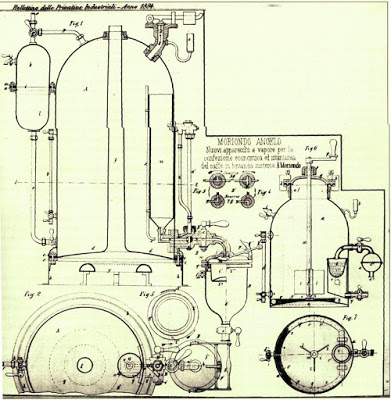
Of course, it can not be said to be born out of thin air, before this, countless coffee extraction equipment has been designed and invented. Some put forward concepts similar to mocha pots, others are similar to today's tea makers, and the concepts most valued by the espresso system may be steam and pressure.
An obsession with steam
Inventors at that time believed that steam was important for coffee extraction. Some people think that it is necessary to wet the coffee powder with steam before extraction; it is more generally believed that after hot water extraction, steam can extract the last drop of coffee essence. On the other hand, perhaps because steam can provide extra pressure on the boiler, slightly increase the water pressure of the extraction, can increase the speed of extraction.
Perhaps it was between the first and second industrial revolutions, when people had a passion and fascination with machinery, steam and efficiency. From our point of view today, the coffee of this period may be too exquisite to swallow.
One cup at a time.
Then, in 1901, Luigi Bezzera created the brewing handle.
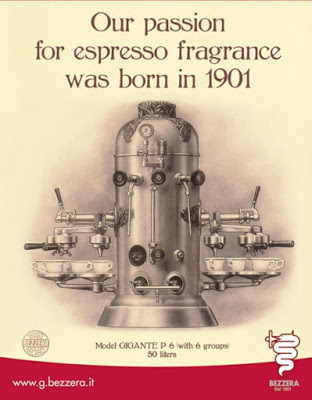
Since then, the commercial value of commercial coffee machines has increased greatly. You can make one cup of coffee at a time in a more efficient way without any other wear and tear! This can be said to be an epoch-making invention at that time! Although the basic model of the built-in is almost exactly the same as the prototype of the Italian machine designed by Angelo Moriondo, and coffee is extracted by hot water and steam, the basic appearance features of the espresso machine as we know it are already in place by this time: brewing handles, pressure gauges, and steam for heating milk.
Finally introduce the pressure!
For nearly five decades, until the birth of the Gaggia piston lever spring coffee machine in 1948, the espresso machine quietly evolved in an invisible place. Add pump, rotary piston to increase extraction pressure, add electronic heating equipment, improve boiler efficiency. Wait. Then, the piston lever spring coffee machine changed everything: ── Creama, the most important feature of Espresso, finally appeared!
Spring piston type Italian coffee mechanism
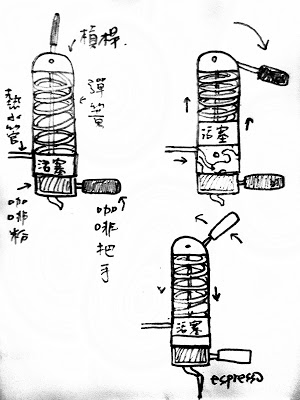
With the extra pressure provided by springs and pistons, the extraction water pressure of the espresso machine finally broke through the nine atmospheric pressure. Because the hot water is pressurized directly on the brewing head, the pressure in the boiler can be decoupled from the water pressure during brewing, and we can finally extract coffee with lower temperature and higher pressure! When the shining Creama flowed out of the machine designed by Gaggia, we can almost imagine the expression on his face, full of joy and surprise.
Application of heat exchanger
After finally being able to extract coffee under high pressure, the next question facing the espresso machine is how to supply high-quality coffee steadily and in large quantities. How to master and manipulate all the extraction variables? Among them, the greatest impact, but also the most difficulties to overcome is the extraction water temperature.
If the traditional single-boiler machine is extracted continuously, it is easy to cause the boiler to cool down and the extraction temperature to change constantly, which will lead to the instability of coffee quality. This problem, born in 1961, has been solved in a breakthrough on E61, which is famous in history.
The E61 is the first to adopt the heat exchange design. The traditional coffee machine uses the hot water in the boiler directly and then pressurizes the head, while the E61 uses a pump to directly pressurize the water in the heat exchanger to keep the water used for extracting coffee at a constant temperature.
In the Italian coffee machine such a short time and high pressure extraction environment, a little variable will greatly affect the taste of coffee. When the powder is thicker and finer, the number of seconds of extraction is increased or decreased by five seconds, or the temperature difference of the water is one degree, the taste of coffee will change greatly. After E61, the design of espresso machine focuses on how to maintain temperature stability.
Since then to modern times, the coffee machine has developed double-boiler and multi-boiler models, with the same emphasis on the rapid and stable supply of large amounts of coffee. At this point, almost all the factors have been controlled, and the development of Italian coffee machine has reached maturity.
Press: around 2010, a batch of Italian coffee machines, including La Marzocco, were designed to control the extraction pressure. The espresso machine has been developed for more than a hundred years, and all the pieces of the puzzle seem to have been completely made up. )
Model and construction of modern Italian coffee machine
Single boiler
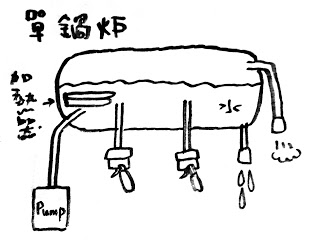
The only single-boiler machine left may be a spring-piston coffee machine (probably not easy to buy). The biggest disadvantage of single boiler is that the water temperature is relatively unstable. When the hot water reaches the boiling head, it will cool down first, and if it comes out of the cup continuously, it will also cause the water temperature to drop.
In order to get a stable extraction, it is necessary to spend more time on drainage, warm boiling head, and then extract when the boiler water temperature and cooking head temperature are stable.
Single boiler and heat exchanger
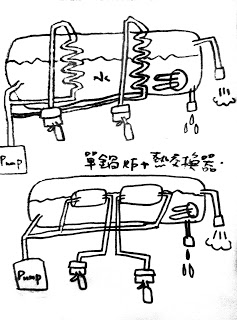
The design of single boilers and heat exchangers is still common today. The biggest advantage of this model is that it can keep the hot water fresh of the extracted coffee, and the temperature stability of the brewing head varies according to the design of different brands. Drainage once before extraction is beneficial to maintain the temperature of the cooking head.
In particular, it should be noted that because it is a single boiler, if the hot water and steam in the boiler are cooled due to the continuous use of tea or steam, it will affect the water temperature of coffee extraction. Therefore, when continuous use of boiler hot water, it is necessary to wait for a period of time to reheat the boiler, and then extract coffee.
Double boilers and multiple boilers
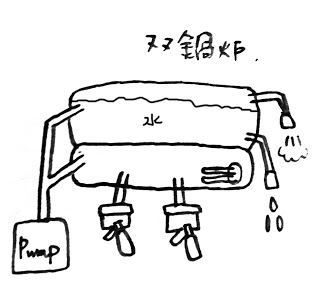
In order to make the water temperature of coffee extraction more stable, the double boiler model is one boiler for extracting hot water for coffee and one boiler for steam and tea. On the other hand, multi-boiler machines have their own independent boilers for each coffee brewing head. Regardless of whether it is a double-boiler or multi-boiler model, because each boiler has an independent heater, the water temperature will be quite stable. The additional benefit of multiple boilers is that different boiling heads can set different water temperatures, or if each head is used in turn, the extraction temperature can be more stable.
So, in the end, how should we choose the right espresso machine?
Please look at:
Selection Guide for Home Coffee machines | Coffee machines recommended for lattes, cappuccinos and cappuccinos
How to distinguish the quality of semi-automatic coffee machine? Selection and purchase Strategy of Italian Coffee Machine
.
Important Notice :
前街咖啡 FrontStreet Coffee has moved to new addredd:
FrontStreet Coffee Address: 315,Donghua East Road,GuangZhou
Tel:020 38364473
- Prev

Which is easy to use, full-automatic coffee machine or semi-automatic coffee machine? introduction to the characteristics of coffee machine.
Professional barista communication please follow the coffee workshop (Wechat official account cafe_style) simply put, this is the choice of the machine at the beginning, your problem and some recipes are dedicated semi-automatic coffee machine, so if you want to use it, you should buy semi-automatic at the beginning, but if the company wants to use it, it is more appropriate to buy full-automatic coffee machine. The advantage of automatic coffee machine is convenience.
- Next

The birth and principle of Coffee Powder dispenser advantages of using Coffee Powder dispenser
Professional coffee knowledge exchange more coffee bean information please pay attention to the coffee workshop (Wechat official account cafe_style) the correct method of filling espresso coffee powder means the birth of coffee powder cloth powder refers to the uniform distribution of coffee powder before pressing, in preparation for pressing powder. In the early years, most baristas used to spread powder directly by hand. In recent years, in order to make the powder more uniform, cloth
Related
- What is the Philharmonic pressure? How to use Philharmonic pressure to make delicious coffee
- Why does a hand grinder have more fine powder than an electric grinder?
- In addition to the hot mom, what is the difference between the versions of EK43 | ditting and Mahdi ek43?
- What kind of equipment do you need to make coffee by hand? Introduction to novice starter cooking equipment tools
- Espresso needs to be ground how thick and thin scale entry Italian Coffee Machine Bean Grinder investigation and Grinding course
- How much does it cost to open a small private cafe? How much does it cost to learn coffee? How to operate it?
- The difference between the flavor characteristics of hand-brewed coffee and coffee maker is hand-brewed coffee really better than coffee maker? Can I use a coffee machine to make coffee beans by hand?
- The difference between 01 and 02 of hario v60 filter cup what is the difference between 01 and 02 filter cup opening and cooking flavor
- What's the difference between the smart cup and the French kettle? Which is better, the French kettle or the Smart Cup?
- What's the difference between a smart cup and a V60 filter cup? The difference between the taste of smart cup and hand-brewed coffee

